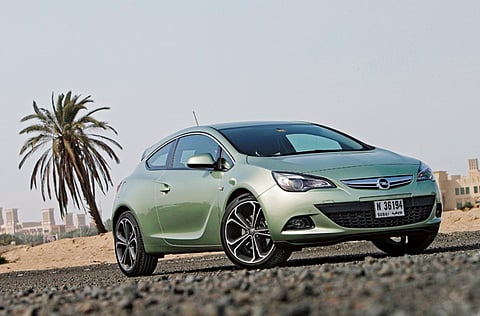Sweet new Astra tested in the UAE
Can the new Opel claim any territory in a tough segment?

Twenty-inch tyres. Why? To handle 140 horsepower? A Volkswagen Golf GTI comes with 17s, optional 18s, and the Golf R gets optional 19s. This new Opel Astra GTC has just burst through the door in the UAE’s automotive market, and it seems to have done so wearing Eighties disco platforms. All the ‘donk’ wheels and tyres are doing is increasing the fuel consumption, probably slowing acceleration and definitely affecting the ride comfort.
The perceptible suspension travel would probably be effective if only the car’s chassis had some tyre sidewall to work with. With these sport-treaded Continentals, it doesn’t. So no matter what the dampers are doing to cushion the ride, to an extent, the tyres spoil it. It is a great-looking coupé though, managing to involve its character creases in its design ethos instead of just slapping on some lines for dramatic effect — look out for the details such as the rear fender kinking into the handle bars and the X at the three-quarter where the side and rear windows meet in the C-pillar.
Viewed side-on, I thought that the tyres would raise the ride height, but because of the ultra-low profile and much smaller section tyre, it’s actually smaller in total diameter than a base-spec set-up. Still, they’re too big on this coupé, which is all about proportions and road stance. The car is beautiful, but it sits like an SUV. The interior has very little to discern this rather expensive coupé from the feel of a regular hatchback. Despite the fairly average materials and the absence of a touch-screen, sat-nav, or branded audio system, the equipment is competitive.
If you actually stop gawping at it and give it a go, you find that the Astra GTC handles really well. It refuses to unstick the rear with quick throttle lift-off and keeps tugging towards the inside of the corner with each degree of steering input applied. Alright, so I guess a lot of rubber pays off sometimes… I also later found out that the GTC comes with torque-steer-negating front suspension from the OPC shelf — OPC being Opel’s high-performance laboratory — which makes sense.
So feel free and securely carry all the speed you want into that corner, because momentum is all you’ll have to go by anyway. I remember moaning initially about the Chevrolet Sonic and Cruze not giving us the option of GM’s 1.4-litre turbocharged engines, instead getting only naturally aspirated hand-me-downs. This modern powerplant, first launched in 2008, powering the Astra GTC has no turbo lag, but that’s because you don’t need huge boost pressure to muster up 100bhp-per-litre in a force-fed motor.
A whiff of exhaust through the manifold will send this tiny turbo spinning to provide decent power from low in the rev range, even if the maximum figures only peak at 4,900rpm — which, to be fair, is about 1,000 revs sooner than with comparative engines from the competition, like Volkswagen and Peugeot. On paper, the GTC should have a carefree four-cylinder engine, serving up its 200Nm of torque early on from 1,850rpm and gliding through a six-speed automatic transmission.
But the power delivery is lumpy (could it be an improperly run-in engine?) and the transmission married to this engine has seemingly filed for divorce — changes are abrupt and particularly on the downshifts you will actually be lurched in your seat. I also didn’t especially enjoy the earlier-than-usual downshifts, followed by hasty engine braking, only for me needing to accelerate again in traffic and the gearbox to be hunting for a higher gear this time. Some discrepancy there.
At Dh95,000, this is an expensive car (just wait for the Golf Mk7) in what is basically base interior trim with showy wheels and tyres to arm the salesman with enticements. But the excellent chassis gives us hope for the OPC in the GCC, which is rumoured to be just around the corner.
Sign up for the Daily Briefing
Get the latest news and updates straight to your inbox



